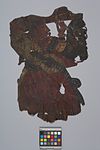tholu bommalata (Shadow Puppet)
About this object
History of use
Puppetry, particularly shadow puppets, is an ancient dramatic form in India mentioned in the Buddhist Jataka Tales of the 3rd century B.C.E. Nowadays modern forms of entertainment, such as the Hindi film industry, have rendered them extinct except for some rural areas in the states of Orissa, Kerala, Andhra Pradesh, and Tamil Nadu. The Andhra Pradesh/Karnataka shadow puppet tradition, compared to the few remaining troupes, are the most extensive and dramatic. Probably originally Maharashtran and maintained by dynasties, such as the Vijaynagars of the 13th and 14th centuries, it now survives as presented by Marathi-speaking puppeteers, commonly called Raoji. These are the largest in size of the Indian shadow puppets.
Iconographic meaning
Represents one of many minor spirits of Hindu folk tradition, Nagini ('naga' means 'ever-moving'), a deity that is half serpent, half human, believed to be courageous and violent. The female aspect is auspicious for women, being symbolic of water and fertility. Nagini is an attendant of Rama in the Ramayana.
Physical description
A shadow puppet of transparent leather cut out representing a female figure. Around the torso, there is a coiled rope design that re-emerges under her half-raised arm as seven snake heads. Holding a striped sash above the head and wearing lavish jewelry on the wrist, ear, and throat as well as a dangling flower nose pin. Figure is dyed red and black. Black areas are perforated.
